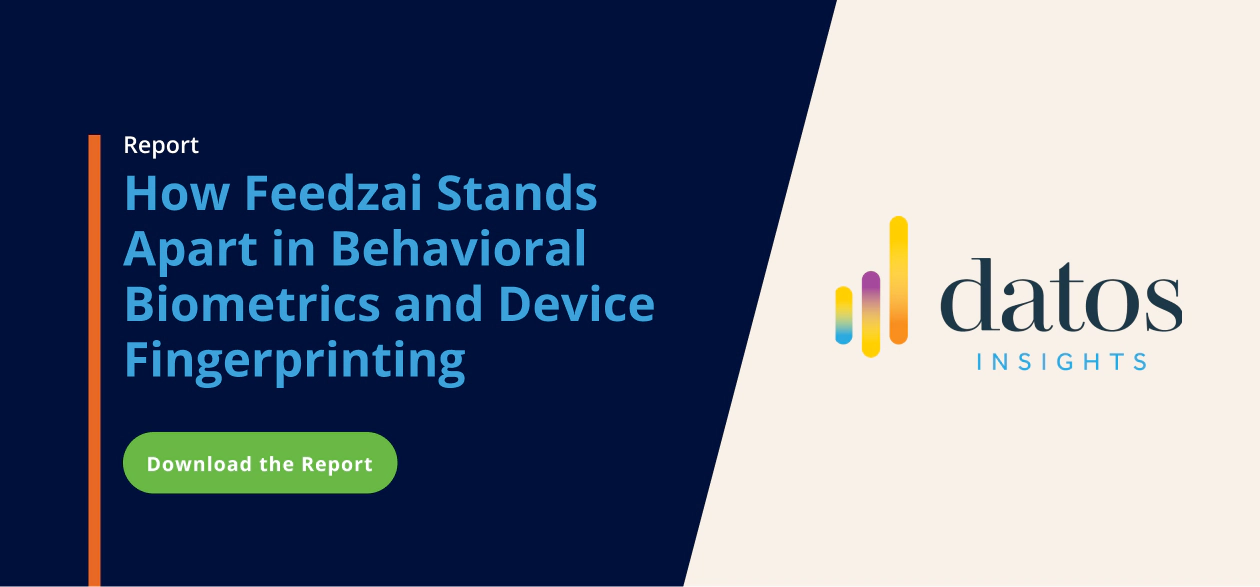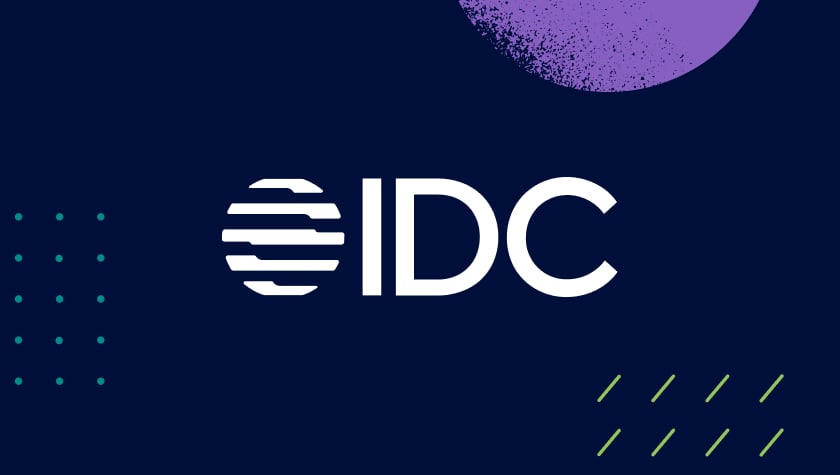
Trust between banks and customers is a two-way street. First, banks must trust that the person they are dealing with is a legitimate customer and authorized to perform the requested transactions. Second, customers must trust their bank to secure their assets and deliver a safe customer experience. Feedzai’s new, enhanced Fraud Model for Digital Trust with AI allows banks to reduce fraud and strengthen customer trust in the digital age.
Learn how this new AI-based model empowers banks to leverage behavioral biometrics, device intelligence, and big data to reduce fraudulent transactions and false positives while strengthening customer trust in the digital age.
4 Key Challenges for Banks That Threaten Customer Trust
Banks must constantly walk a fine line in their efforts to prevent fraud while offering customers a seamless experience. However, meeting customer expectations can be challenging, especially given current market realities.
Banks Face Pressure to Reduce Costs
Workforce reductions have been one of the top challenges that banks face. In the US alone, some of the nation’s largest banks cut their labor force by as much as 7%. While this might be a necessary step for banks to tighten their belts, it can also contribute to lower employee morale, overwhelm remaining personnel, and hurt the bank’s overall performance.
Banks Still Rely on Older Legacy Systems
Many banks still contend with legacy systems. Recognizing restrictions this places on remaining competitive most are either starting the process or have already migrated their tech stack to a cloud-based system and streamlining their technology infrastructure. Such moves are likely to result in strong payoffs. Recent McKinsey research indicates updating technology stacks can reduce operating costs by 20-30%.
Banks Still Struggle to Tap Into the Power of Big Data
Older legacy systems also make it difficult for banks to tap into the opportunities offered by big data. Customers are becoming increasingly tech-savvy, giving institutions more access to data than ever before. But for many institutions, the challenge now lies in how to manage large volumes of data. Data science teams and fraud analysts must create rules and models to manage the collected intel. Additionally, they must ensure they have the right technology in place to enable them to do so.
Banks Must Deliver a Seamless Digital Experience While Preventing Fraud
A top-notch customer experience begins at onboarding. Recent research shows that going digital greatly contributes to bank customers’ satisfaction and improves the likelihood that customers will buy more of the bank’s products and services.
At the same time, 20% of customers would consider switching banks as it becomes easier to open a new account. This ease of account opening is a double-edged sword for banks. Banks can onboard new customers easily, delivering a seamless user experience. However, fraudsters are ready to exploit this same process to commit new account fraud.
3 Common Limitations of Existing Market Solutions
Banks have access to different types of fraud detection systems. But while solutions currently exist that address fraud and customer service challenges, they come with important limitations.
Transactional Data Only
Many vendors use fraud detection systems that rely solely on transactional data. Even though these systems might achieve high detection by themselves, they increasingly miss out on relevant data that can help improve the financial institutions’ risk strategy and reduce customer friction. This provides a narrow view of the overall risk picture and creates an opening for fraudsters to exploit.
Enrichment from Third-Party Vendor
Many financial institutions and banks work with third-party vendors to enrich their native transaction data. While this provides deeper insights into the data, it also adds complications. For example, banks may find themselves dependent on external partners, which slows down real-time decision-making.
Single Solution Vendors
Many vendors offer single solutions to specific challenges. This may include behavioral biometrics, device fingerprinting, or malware detection as individual solutions. Without a holistic approach to address the fraud challenge, blind spots emerge that enable fraudsters to avoid detection.
For example, maybe one provider only reviews device intelligence while another checks for threat intelligence and malware detection. These providers may not find anything suspicious in their respective fields. However, if they had behavioral biometric insights, they would realize the user handles their device differently. This blind spot gives fraudsters an opening to commit fraud unnoticed.
How the Feedzai Digital Trust Fraud Model Works
Feedzai’s Digital Trust Fraud Model allows banks to better protect their users by using artificial intelligence to review large amounts of data quickly. This enhanced model is the result of Feedzai’s ongoing efforts to improve financial institutions’ lives as well as their customers’ lives.
Here’s what sets the solution apart.
3-in-1 Approach to Fraud Prevention
The Digital Trust Fraud Model is a single solution that combines three critical elements:
- Behavioral Biometrics. Behavioral biometrics analyze a user’s unique behavior patterns, such as how they type, move their mouse, or tap their device screen for unusual activity.
- Device Fingerprinting. Device fingerprinting identifies and tracks devices based on their unique characteristics, including hardware configurations, software settings, and network attributes.
- Malware Detection. Malware detection detects and prevents malicious programs on computer systems that attempt to gain unauthorized access, steal data, or compromise systems.
By collecting data across these three pillars, the solution creates a comprehensive understanding of each individual. This 3-in-1 approach grants visibility over significant changes in the users’ behavior and creates a 360-degree understanding of how each individual interacts with their banking website or app. Banks can quickly determine if an account takeover attack or identity theft attempt is underway.
Human-centric AI
Feedzai has always strived to make human-centered AI a central pillar of our solutions. This approach seeks to view customers as individuals with their own unique behaviors and attributes. To that end, Digital Trust builds a hypergranular identification of each user called the BionicID that acts as a unique digital fingerprint.
The BionicID collects each user’s biometric, behavioral, network, device, and threat data across their entire lifecycle. By asking, “Are you really you?” at each interaction, the solution always evolves instead of remaining static.
This approach neatly summarizes how Feedzai puts customers at the center of risk-based decisions. In addition to the BionicID, using an AI-first approach to fraud prevention and detection, the fraud model integrates past fraud labels. Using this information, the model determines if recent behaviors are potentially fraudulent or not.
This ability enhances accuracy and improves prevention efforts by allowing financial institutions to stop potential fraud before a transaction is completed. This improves confidence in investigations and can significantly improve fraud detection rates for financial institutions by as much as 10%. The Fraud Model empowers banks to improve decision-making during investigations, prevent fraud, and foster growth by promoting a seamless user experience.
Active User Protection
Digital Trust can trigger automated responses for a particular threat. For example, the solution can step up authentication requirements or terminate a web or app-based banking session if the system suspects an impersonation or manipulation attack is underway.
Another option is to alert the fraud team of the averted attack allowing them to send a follow-up response. This can range from sending user notifications to temporarily suspending threatened accounts. Banks can assess the model’s findings to determine if the risk measured by the model matches their own risk appetite. Depending on the result, banks can decide their own course of action. In other words, the bank, not the solution, is the final decider of its own risk.
An integrated view of risk from a single vendor
Financial institutions can leverage an integrated solution to enhance fraud detection, minimize losses, and streamline the customer experience. By analyzing user behavior, such as swiping, clicking, and typical usage patterns, along with recognizing safe devices and online interactions, fraud attempts can be identified proactively.
Feedzai’s Digital Trust, combined with Transaction Fraud for Banking, merges user knowledge with transactional data, behavioral insights, and AI-powered risk inputs to deliver a comprehensive view to validate mobile and web interactions and strengthen the fight against fraud and financial crime.
Why Choose Feedzai?
Feedzai’s new Fraud Model for Digital Trust gives financial institutions the confidence they need to prevent fraud instead of just detecting it. The model draws from various signals and data to uncover and identify fraudulent sessions.
Partnering with Feedzai offers several critical benefits, including:
Work with an award-winning partner
Feedzai is a proven leader in the fraud and financial crime prevention sector with recognition in numerous categories, including in technology excellence. Our Digital Trust solution, in particular, has been recognized by multiple analyst firms for behavioral biometrics and device fingerprint capabilities.
A commitment to R&D
We are also committed to constantly enhancing and improving our solutions. That’s why we reinvest more than a quarter of our revenue into research and development. The Digital Trust Fraud Model is the result of our ongoing effort to help financial institutions catch more fraud with ease.
Putting customers in control
Perhaps most importantly, clients can adjust how the different risk indicators are incorporated into their own Risk Strategy based on their institution’s specific needs. This puts clients in control of their own risk decisions.
Feedzai’s Digital Trust Fraud Model leverages a wide range of data to enhance banks’ ability to detect fraud and trust that they only deal with trustworthy customers. Customers, meanwhile, can trust their bank to deliver a seamless experience with minimal friction.
Trust Feedzai to help your organization uncover more fraud while delivering the seamless customer experience today’s digital-savvy customers expect.
Share this article:
Related Posts
0 Comments6 Minutes
A Guide to Secure, Seamless User Authentication in Payments
Online payments demand a delicate balance between security and user experience. Consumers…
0 Comments7 Minutes
Combating Emerging Scams in the Philippines
The Philippines is witnessing remarkable growth in digital banking. Unfortunately, a…
0 Comments5 Minutes
Feedzai is a Leader in the 2024 IDC MarketScape for Enterprise Fraud Solutions
Exciting news! Feedzai, the world’s first RiskOps platform, is proud to have been named a…


